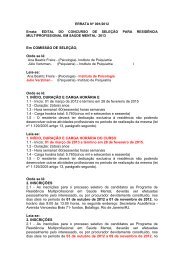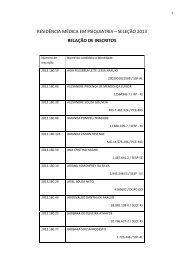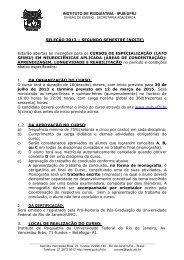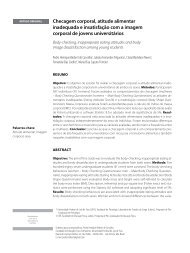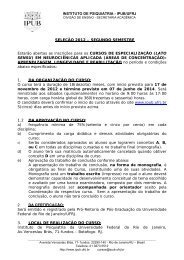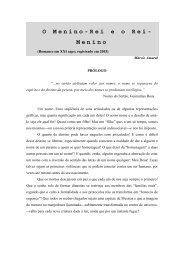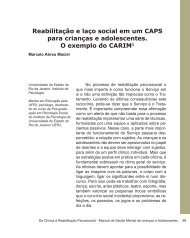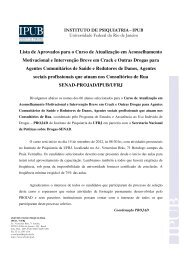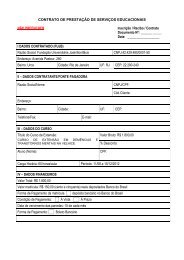Originais â Originals outubro | dezembro ⢠2011 - IPUB - UFRJ
Originais â Originals outubro | dezembro ⢠2011 - IPUB - UFRJ
Originais â Originals outubro | dezembro ⢠2011 - IPUB - UFRJ
You also want an ePaper? Increase the reach of your titles
YUMPU automatically turns print PDFs into web optimized ePapers that Google loves.
ORIGINAL ARTICLE<br />
Factors related to dissatisfaction in adolescents<br />
319<br />
on the relationship between obesity and body dissatisfaction<br />
found, without exception, greater body dissatisfaction<br />
among heavier children and adolescents, confirming that<br />
overweight during adolescence may indicate greater body<br />
concern and discomfort.<br />
The high correlation between body image and anthropometric<br />
characteristics suggests that the analysis of body<br />
image perception could play an important role in nutritional<br />
surveillance 24 .<br />
According to Champion and Furnham 26 , many theorists<br />
have postulated that the media may play a central role in<br />
creating and exacerbating the phenomenon of body dissatisfaction.<br />
Television and other media represent one of the<br />
most important and underrecognized influences on children<br />
and adolescents’ behavior 27 . Figures in the media provide information<br />
on fashion, beauty, and body satisfaction, and have<br />
the potential to provide positive images for adolescents in<br />
the process of their social development and emerging sense<br />
of identity. However, adolescents often identify with media<br />
characters who are unnaturally thin or who engage in harmful<br />
behaviors, and often develop unrealistic and unhealthy<br />
norms of physical appearance 28 .<br />
The adult stereotypes of beauty and obesity are naturally<br />
assimilated by children and a review conducted by Feldman<br />
et al. 29 investigating the absorption of these stereotypes in<br />
children concluded that children by the age of 6-9 years old<br />
already acquire an active dislike of the obese body and by<br />
the age of 7 years have assimilated adult cultural perceptions<br />
of attractiveness 26 .<br />
According to Pesa et al. 30 , adolescence is a period of life<br />
marked by pronounced physical, psychological, emotional,<br />
and social changes. The physical changes that characterize<br />
this life stage have been implicated as a trigger for body<br />
image problems in both males and females. With pubertal<br />
development, girls experience an increase in body fat 31 . This<br />
new body often conflicts with the cultural ideal of a slender<br />
body and girls generally become more dissatisfied with their<br />
bodies. It stands to reason that excess body weight may have<br />
a negative impact on the well-being especially of female adolescents<br />
31 . In fact, dissatisfaction with body image in girls is<br />
normally shown by the desire to lose weight. In contrast, studies<br />
have shown that boys seem to be approximately equally<br />
divided between those desiring weight gain and those desiring<br />
weight loss 8 , as confirmed in the present study.<br />
This study has presented numerous interesting findings.<br />
Nevertheless, it is not without limitations. This study has presented<br />
numerous interesting findings. Nevertheless, it is not<br />
without limitations. The first one is related to the use of one<br />
self-applicable instrument, which may contain a bias component,<br />
once it depend on those who will answer the questions,<br />
fact that can result in subjective data. Second, there<br />
is the relatively small sample size, which could not properly<br />
represent all considered strata, but may provide baseline<br />
data to begin to examine body dissatisfaction and its related<br />
factors during adolescence.<br />
In conclusion, boys and girls differed significantly in body<br />
dissatisfaction, with girls reporting higher levels of dissatisfaction.<br />
In general, underweight and normal weight boys<br />
would like to be heavier, while those overweight would like<br />
to be thinner and, in contrast, girls would like to be thinner,<br />
even when they are of normal weight. Contrary to expectations,<br />
body image dissatisfaction was strictly related to BMI,<br />
but not to physical activity.<br />
These results demonstrated that biological factors, as<br />
BMI, may play an important role in the development and<br />
maintenance of body image dissatisfaction and provided<br />
helpful information about risk population that should be target<br />
of interventional programs.<br />
ACKNOWLEDGE<br />
The authors acknowledge Fundação de Amparo à Pesquisa do<br />
Estado de São Paulo – FAPESP for financial support (Process<br />
2006/01606-6).<br />
REFERENCES<br />
1. Powell MR, Hendricks B. Body schema, gender, and other correlates in nonclinical populations.<br />
Genet Soc Gen Psychol Monogr. 1999;125(4):333-412.<br />
2. Smolak L. Body image in children and adolescents: where do we go from here? Body Image.<br />
2004;1(1):15-28.<br />
3. Brausch AM, Muehlenkamp JJ. Body image and suicidal ideation in adolescents. Body<br />
Image. 2007;4(2):207-12.<br />
4. Cash TF, Deagle EA. The nature and extent of body image disturbances in anorexia nervosa:<br />
a meta-analysis. Int J Eat Disord. 1997;22(2):107-25.<br />
5. Jankauskiené R, Kardelis K. Body image and weight reduction attempts among adolescent<br />
girls involved in physical activity. Medicina (Kaunas). 2005;41(9):796-801.<br />
6. Thompson JK, Heinberg LJ. The media’s influence on body image disturbance and eating disorders:<br />
we’ve reviled them, now can we rehabilitate them? J Soc Issues. 1999;55(2):339-53.<br />
7. Stice E, Bearman SK. Body image and eating disturbances prospectively predict growth<br />
in depressive symptoms in adolescent girls: a growth curve analysis. Dev Psychol.<br />
2001;37(5):597-607.<br />
8. Furnham A, Badmin N, Sneade I. Body image dissatisfaction: gender differences in eating<br />
attitudes, self-esteem, and reasons for exercise. J Psychol. 2002;136(6):581-96.<br />
9. Jones DC. Body image among adolescent girls and boys: a longitudinal study. Dev Psychol.<br />
2004;40(5):823-35.<br />
10. Bardone-Cone AM, Cass KM, Ford JA. Examining body dissatisfaction in young men within<br />
a biopsychosocial framework. Body Image. 2008;5(2):183-94.<br />
11. Van den Berg P, Paxton JS, Keery H, Wall M, Guo J, Neumark-Sztainer D. Body dissatisfaction<br />
and body comparison with media image in males and females. Body Image.<br />
2007;4(3):257-68.<br />
12. Placek JH, Griffin LL, Dodds P, Raymond C, Tremino F, James A. Chapter 3. Middle school<br />
students’ conceptions of fitness: the long road to a healthy lifestyle. JTPE. 2001;20(4):<br />
314-23.<br />
13. Aaron DJ, Dearwater SR, Anderson R, Olsen T, Kriska AM, Laporte RE. Physical activity<br />
and the initiation of high-risk health behaviors in adolescents. Med Sci Sports Exerc.<br />
1995;27(12):1639-45.<br />
J Bras Psiquiatr. <strong>2011</strong>;60(4):315-20.




